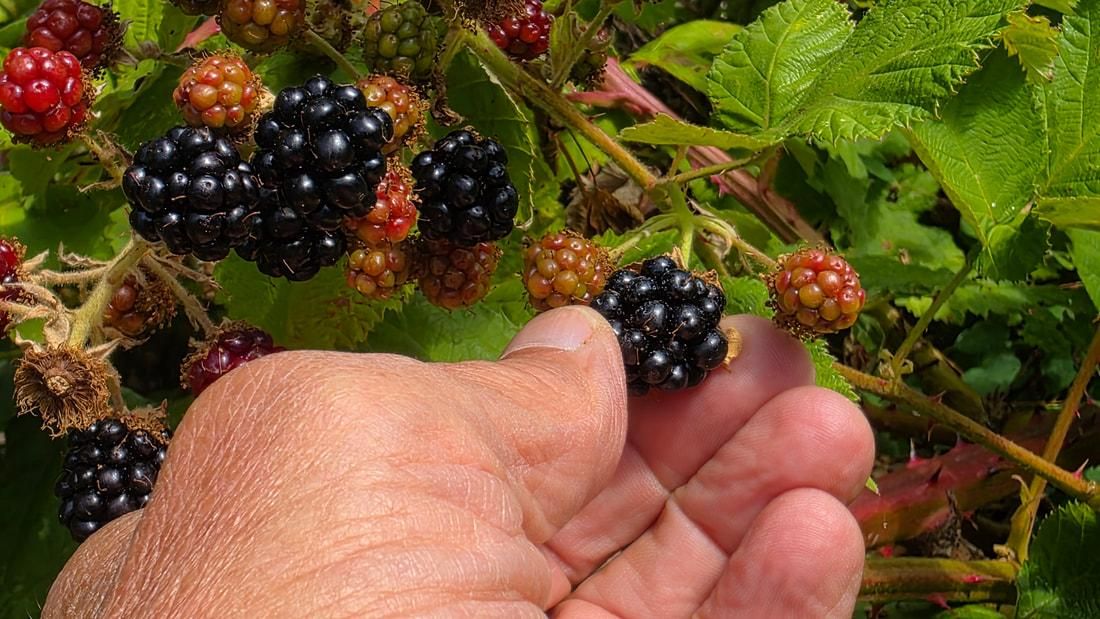It’s a love/hate relationship. Himalayan blackberries are as much a part of the view as the Salish Sea — the twisting brambles are ubiquitous, both loved and loathed. They will catch your clothing and scratch your skin, guaranteed. We engage in a never-ending battle with their stickery canes, while also enjoying the fruit they bear. They taste like summer, the berries indescribably sweet and scrumptious. A fully ripe berry explodes with flavor in our mouths as an orgasmic delight.
- View a 4-minute video on YouTube.
How do you tell if it’s ripe? A ripe Himalayan will come free with nothing more than a gentle nudge. (The fruit is technically not a berry, but “an aggregate fruit of numerous drupelets.” Now you know. I still call them berries.)
Why is it called a Himalayan? It is not from the Himalayas. It originated in Armenia and northern Iran.
In the 1800s, an amateur botanist in California, Luther Burbank, worked feverishly to breed new kinds of plants. You know some of his creations: the Shasta Daisy and the Freestone Peach. Burbank also traded seeds with fellow collectors from around the world. In 1885, in a package from India, he found seeds for a huge blackberry with an even bigger flavor. He named it the Himalaya Giant. He found that this blackberry grew like crazy — especially in temperate areas like the Pacific Northwest. So, he offered the berry for sale here, not mentioning how aggressively it would take root.
By the early 1900s, his Himalaya Giant — what we now call the Himalayan blackberry — was thriving here, taking over any ground it touched.
Because it is so hard to contain, it quickly gets out of control, with birds and other animals eating the fruit and then spreading the seeds. With their extensive root systems, Himalayans can survive drought. Not only are their roots spread out over a wide area, they also can go deep underground, allowing them to reach water that most smaller plants and shrubs cannot.
They can grow in dry soil, wet soil, forest shade, and full sun.
And once the plant is growing, the tip of a vine touching the ground can create a new plant.
Cutting the canes to the ground or burning thickets doesn’t kill them. Broken roots can resprout. The only guaranteed removal strategy is to completely dig up the deep rhizomes. And repeated cutting of all the vegetation, a few times a year, year after year, will also work … eventually.
The berries are ripening along many of our trails and roadsides. The first ones to ripen, at the tips, are particularly sweet, or maybe that’s just because it has been ten months since I’ve had a fresh blackberry.
We walked along the Tommy Thompson trail this weekend, as trail users by the hundreds walked, dog-walked, rode, strode, jogged, peddled, ambled, scooted, sped, and skipped by us.
Some stopped to sample the earliest of the berries. The canes grow along the seashore, invade the trail, climb the bank toward Fidalgo Road, then climb the trees above the road. They are spreading toward the trestle and getting closer to downtown.
Morning glory, nettles, nightshade, goldenrod, yarrow, and a host of others, even English ivy, try to poke their way through the blackberry vines. But if you come back in ten years to see who wins, I bet you will be able to pick more blackberries than ever.
Speaking of which, isn’t it ironic for me, a human, to be talking about an invasive species taking over the environment, however sweet I may be?
Notes
In our Pacific Northwest, we find three blackberries. Unfortunately, only one of them is native. The trailing blackberry, Rubus ursinus, small and flavorful, its taste sweet and intense, is native here, but hard to find. The non-native Evergreen blackberry, Rubus laciniatus, has leaves of five leaflets, all dark green, spiky, and jagged-looking. And then there is the Himalayan blackberry, Rubus armeniacus.
Directions
Directions: In Anacortes, R Avenue is closed right now between 22nd and 34th, so take one of those two streets to go east from R Avenue to pick up the trail. That's one reason we started at the east end of the trail, on the west side of March's Point, about a 3/4 of a mile north of Highway 20, where there is very limited parking.
By Bus: Island and Skagit Transit go to March's Point Park and Ride; then walk or bike the 3/4 mile to the east end of the trestle. Or take the Skagit Transit 410 bus into Anacortes, get off at 10th and Q, and walk east to reach the path along the waterfront.
By Bike: see the directions above. The trail is ideal for biking too.
Mobility: the entire trail is paved (except for the tight planking on the trestle), wide, relatively flat, free of cars except where it crosses roadways, and full of adventure waiting for you. And blackberries!
